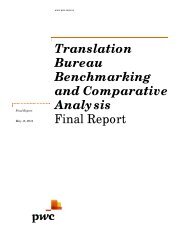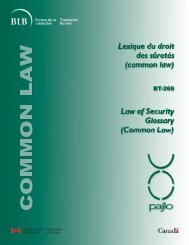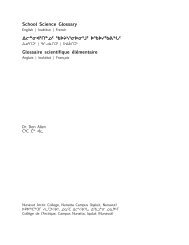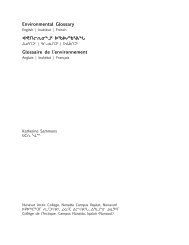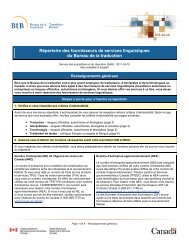Glossaire d'archéologie / Archaeology Glossary - Bureau de la ...
Glossaire d'archéologie / Archaeology Glossary - Bureau de la ...
Glossaire d'archéologie / Archaeology Glossary - Bureau de la ...
Create successful ePaper yourself
Turn your PDF publications into a flip-book with our unique Google optimized e-Paper software.
Foreshaft: ᐃᐱᖅ: Ipiq: Pré-hampe<br />
Part of a harpoon. A shaft of bone, antler, or ivory, usually between 10 and 30 cm<br />
in length. The base of the foreshaft fits into the foreshaft socket, and a harpoon<br />
head is fitted on the tip.<br />
Foreshaft Socket: ᕿᔪᒃᓯᕐᕕᒃ: Qijuksirvik: Cavité <strong>de</strong> <strong>la</strong> pré-hampe<br />
Part of a harpoon. A short bone shaft attached to the end of the harpoon shaft. A<br />
hole is drilled into the end of the socket, into which fits the base of the foreshaft.<br />
Formation Processes: ᓴᓇᔭᐅᓂᖓᓂᑦ ᒫᓐᓇᒧᑦ ᐊᓯᔾᔨᖅᐸᓪᓕᐊᓂᖅ: Sanajauninganit<br />
maannamut asijjiqpallianiq: Processus <strong>de</strong> formation<br />
Natural events or human behaviours that create or modify the archaeological<br />
record. Both categories inclu<strong>de</strong> numerous agents of change, and may contribute to<br />
the preservation as well as <strong>de</strong>struction of the archaeological record. The effects of<br />
wind, sunlight, floods, earthquakes, acidic soil, burrowing animals, bacteria, etc.,<br />
constitute natural formation process. Human behaviours not only create the<br />
archaeological record, but alter or <strong>de</strong>stroy it by reusing and recycling materials, by<br />
looting archaeological sites, and by carrying out various <strong>de</strong>velopment activities,<br />
including construction and agriculture.<br />
Functional Type: ᑭᓱᒧᑦ ᐊᑑᑎᖃᕋᓱᒋᔭᐅᔪᖅ: Kisumut atuutiqarasugijaujuq: Type<br />
fonctionnel<br />
G<br />
A system of artifact c<strong>la</strong>ssification in which specimens are assigned to categories<br />
based on their known or inferred functions or uses (e.g. burin, harpoon head, si<strong>de</strong>scraper).<br />
Geoarchaeology: ᓄᓇᒥ ᖃᐅᔨᓴᕐᓂᖅ: Nunami qaujisarniq: Géo-archéologie<br />
A branch of archaeological research which utilizes the concepts and methods of<br />
the earth sciences (e.g. geology, geography, paleontology and pedology) to<br />
reconstruct the past. Several key archaeological concepts, including stratigraphy,<br />
have been borrowed directly from the earth sciences.<br />
Geographic Positioning System: ᑕᒻᒪᕇᒃᑯᑦ: Tammariikkut: Système <strong>de</strong><br />
positionnement géographique (SPG)<br />
A navigational <strong>de</strong>vice that uses satellites to <strong>de</strong>termine the location of a p<strong>la</strong>ce on<br />
the surface of the earth. Usually abbreviated as “GPS.” Archaeologists use<br />
geographic positioning systems to record the locations of archaeological sites while<br />
conducting surveying, as well as when mapping archaeological sites.<br />
19



